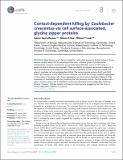Contact-Dependent Killing by Caulobacter Crescentus via Cell Surface-Associated, Glycine Zipper Proteins
Author(s)
Garcia Bayona, Leonor; Guo, Monica S; Laub, Michael T
DownloadGarcia-Bayona-2017-Contact-dependent killing b.pdf (2.030Mb)
PUBLISHER_CC
Publisher with Creative Commons License
Creative Commons Attribution
Terms of use
Metadata
Show full item recordAbstract
Most bacteria are in fierce competition with other species for limited nutrients. Some bacteria can kill nearby cells by secreting bacteriocins, a diverse group of proteinaceous antimicrobials. However, bacteriocins are typically freely diffusible, and so of little value to planktonic cells in aqueous environments. Here, we identify an atypical two-protein bacteriocin in the α-proteobacterium Caulobacter crescentus that is retained on the surface of producer cells where it mediates cell contact-dependent killing. The bacteriocin-like proteins CdzC and CdzD harbor glycine-zipper motifs, often found in amyloids, and CdzC forms large, insoluble aggregates on the surface of producer cells. These aggregates can drive contact-dependent killing of other organisms, or Caulobacter cells not producing the CdzI immunity protein. The Cdz system uses a type I secretion system and is unrelated to previously described contact-dependent inhibition systems. However, Cdz-like systems are found in many bacteria, suggesting that this form of contact-dependent inhibition is common.
Date issued
2017-03Department
Massachusetts Institute of Technology. Department of BiologyJournal
eLife
Publisher
eLife Sciences Publications, Ltd.
Citation
García-Bayona, Leonor; Guo, Monica S and Laub, Michael T. “Contact-Dependent Killing by Caulobacter Crescentus via Cell Surface-Associated, Glycine Zipper Proteins.” eLife 6 (March 2017): e24869 © 2017, García-Bayona et al
Version: Final published version
ISSN
2050-084X